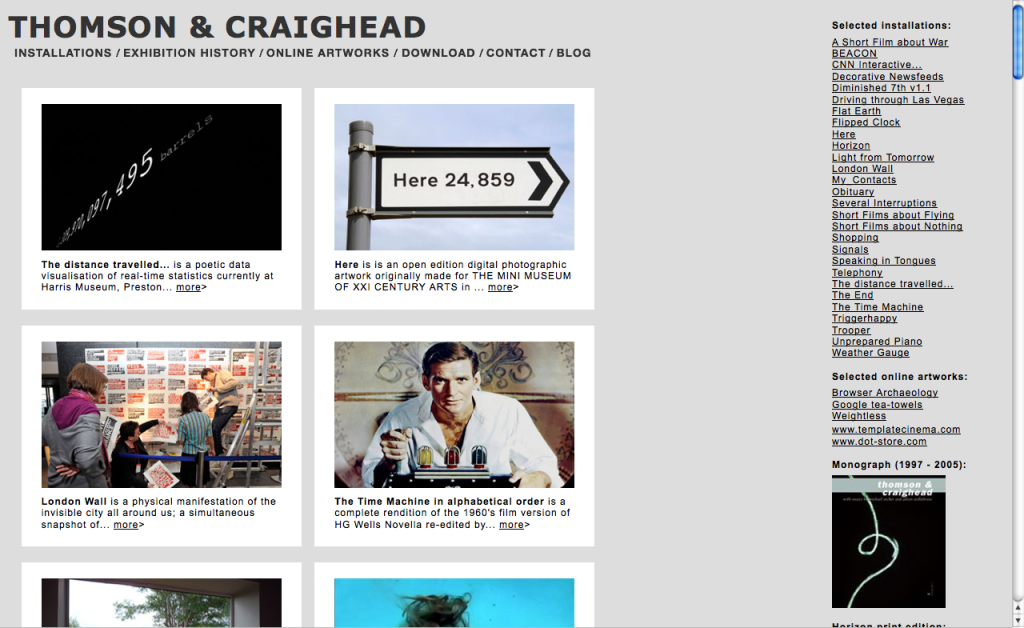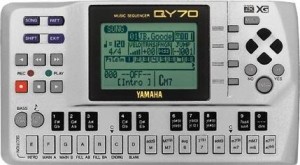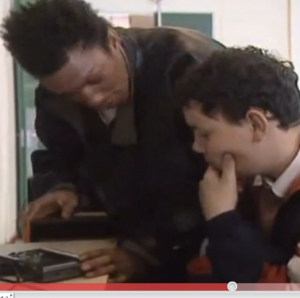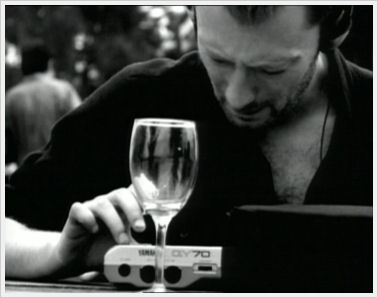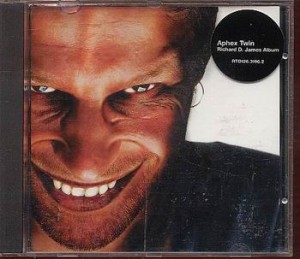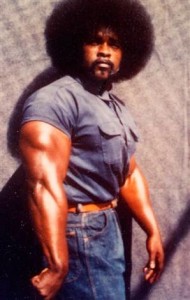[When you read through this interview, launch Thomson and Craighead website so that you can look at the works they are referencing in the interview]
I’ll start off by asking some easy questions. What’s you’re favourite colour?
Alison: Blue.
Jon: That’s not an easy question. I’ll say blue as well.
Are you right handed or left handed?
J: I’m left handed.
A: I’m right handed.
Where did you both grow up?
A: I grew up in Aberdeen and then went to Art College in Dundee.
J: I grew up in South Croydon (London) and ended up doing a foundation art course, in Epsom. I went to do a degree in the midlands and on to Dundee for postgraduate study. That’s when I met Alison.
Do you remember if there was anything in particular that made you decide to go to art school? Was it through exposure to an artwork or a certain artist?
J: I can actually identify it to a particular moment, but it wasn’t so much an experience of art. It was actually more just being at school, ending up doing art as an option in secondary education and then having a bit of an epiphany when I started drawing. Even at that age of fifteen or sixteen it was a transforming experience, because it actually made me see things in a different way.
A: I can’t actually remember. It was a way of opting out that was really exciting…I thought I was going to be a lawyer.
Really!
A: I mean I always liked art and I thought I could do with doing something that I actually liked. That was kind of it.
J: You did a day at law school though.
A: I did a day at law school; I enrolled. Then I realised it wasn’t going to work out, so I did a bit of a runner.
What were your initial interests at university?
J: Initially – at foundation – I did a lot of textile stuff and graphic design, but understood quite quickly that I was interested in fine art practice. By weird coincidence Michael Archer was working at Epsom in the art history department. He was doing a thing called Audio Arts Magazine, along with Bill Furlong. It was a kind of tape cassette based publication. I was given to him as a tutee and he asked me lots of difficult questions about what I was doing as an artist. I was only seventeen or eighteen, probably still trying to get my head around Magritte or something. He really pushed me in a way that I found very difficult at the time. Moving into my degree at Leicester Polytechnic I could just extend that. I did a lot of video for my degree and because of that I went to Duncan and Jordanstone, which has a post-grad course called electronic imaging.
A: I was on a really traditional drawing and painting course at Duncan and Jordanstone. Then I started looking around. I became really interested in computers – I didn’t really know they were called computers at the time – but it all seemed very exciting. So I started sneaking in on the post-grad course and it was great because I got to meet people who’d come from all over the world to do the electronic imaging course, it was amazing. You’d get Swedish performance artists and really established people. It just seemed like the most exciting thing ever.
Was the transition from being interested in art to becoming exposed to discourse – and the idea that it’s a specific site you can situate your work in – a bit of a shock?
J: Well because there was not so much formal teaching during my degree, I got stuck into the Deleuze and Guatarri of the time – I guess late eighties – who I suppose was Jean Baudrillard. I was also reading Frederick Jameson and quite a lot of leftist theory and post-feminist theory. I only understood it within my own capacity as a student at the time; to this day I have a very partial and scattergun understanding of philosophy and theory. But, because there were a few of us that didn’t have much else to do but make work and talk to each other, we started to talk about these things. By the time I got to Dundee, it was a much more practical course where we actually learnt a lot of stuff. I learned a huge amount about sound and video post-production and the whole of that year became very rooted in learning skills.
A: For me it was a bit different, because I was there for four years and so I had more time, but what would happen was older artists would come and do the course and they would kind of become my tutors and say ‘you should read that’ or ‘why are you doing that’. It was really good for me because I got a rounded education.
What was your first piece of work together?
A: That’s quite tricky.
J: It’s a little bit hard to answer definitively because when we first started working together we would do things for each other. So Alison might make a work, which
I’d do the sound recording on, or the sound design. That’s how it begun, with video.
A: That’s pretty much what it was like working with video in the early 90’s. You couldn’t do something by yourself, because you couldn’t physically carry the equipment. So you’d always work with a team. If one person was making a work they’d be like the director, lets say, but then you’d have about four other people.
J: You’d have a Portapak video that you could hardly carry, so you’d need two people: one to hold the camera and the other just behind trailing a cable. We were using what was close to broadcast quality and it was heavy. It was still the days where a VHS home recorder would be really big.
A: What was really good was that you learnt to work in teams. I think if I hadn’t done that, then I wouldn’t be so interested in collaborating. But, early on, if you needed to do anything, you needed to work on other people’s stuff and they needed to work on yours.
In terms of how you both collaborate and use technology, there seems to be a fluency there that makes your work easy to take in. I think the ease with which you utilise and function in both those processes translates to the viewer, allowing complex ideas to be digested. For instance, I can engage with your work without thinking about how difficult it was to produce, unless I want to. This is important because I find the foregrounding of process in ‘new media’, ultimately leads back to the apparatus or software used and that’s usually the last thing I’m interested in. I suppose I’m saying you’ve removed that distraction.
J: That’s good that it seems that way. We strive to make things seem simple; then to almost sneak up behind you and be a bit complicated. So, we do try to find quite singular gestures, which then might proliferate in complexity rather then just having something super complicated in front of you that makes you walk away.
When did you start looking at the Internet?
J: From around 1995-96 onwards, we were looking at the Internet. The reason we were looking was because we had very little money, we had no studio, and we thought well actually this is a conceptual space where you could try stuff out in. You could create diagrams and networks of things that maybe test ideas. Then we got interested in the idea of a hyperlinked environment and what that meant when you see it’s distributed across the whole planet.
Some of your early work seemed concerned with questioning the Internet. For example Dot Store could be looked at as an investigation into the nature of e-commerce. I’d also noticed that in both Rachel Greene’s and Julian Stallabrass’ books about that time, they seemed to situate you within that framework of artists like Vuk Cosic and Heath Bunting who were similarly interested in the Net. Was that something that you felt at the time?
A: Well we knew them all. But, we never actually felt that we were ‘Net Dot’ artists because that was a very specific group.
J: Vuk was the person who coined it all – just as a bit of a joke really. It was him trying to stymie the art establishment, but at the same time commodify his activity. It was quite a strategic move on his part.
A: I think they were a bit shocked that we did stuff in galleries. There was a nod to what we did but it was s a bit like [whispers] ‘They work in galleries’. There was a very strong identity and I think they all became very close actually. I mean Jodi are just fantastic artists aren’t they? They’re brilliant. And they were always a little bit more on the edges.
J: I think Dot Store is the most self-reflexive project we’ve made about the Internet or the web. But actually one of the reasons we made it was as a way of trying to archive a moment. It was just at the end of the dot-com bubble, when we were about to move into the first glimmerings of web 2.0, so we tried to make these really cheesy pieces of museum tat (apart form the tea towels which we made a lot better quality) as a way of creating a Fluxus box of artefacts. It was quite funny because it did make money for a bit.
A: We went to this kind of tech fair, with our tea towels and set up a stall. Can you remember what the name of it was?
J: It was…I can’t remember.
A: Well, we had queues. We were completely shocked. It was really funny. We were run off our feet and came back with a wad of cash and half the tea towels gone. It was a bit like ‘we could have a business here, this is really strange’. But yes, that moment quickly passed.
And Trigger Happy was before, right?
A: It was way before. That was about 1997. So actually, Dot Store was a little like the bookend for a whole series of works.
Would that be the point where web 2.0 comes in?
J: Well it came after, but for us Dot Store was more of a bookend for the dot-com bubble bursting. 2001 was the year that a lot of Net-Art programmes in museums closed down as a result of the bubble bursting.
A: The Walker arts centre shut its programme down and Steve Deitz left. But, I don’t know if we saw it as a bookend because lots of things changed. I think we’d done a whole lot of work and then sometimes there is a point where you have to stop, change and move on. It was like we’d created a full stop.
So at the initial point where you discovered the Internet, did Trigger Happy follow soon after?
A: Pretty Soon.
J: We mad a thing called Weightless, which was a collection of chat-room transcripts and animated GIFS that played themselves out in random combinations. We made Trigger Happy at the same time.
A: With Weightless we were really interested in making it look like television or something that was televised. I guess from there that lead on to a Short Film About Flying, and data-visualisation and it’s relationship to cinema. But, I didn’t know it at the time as I was just doing work and trying to understand what it is I liked about it.
J: At that time all of our stuff online was pretty speculative, because you could only push images about the place and make links to things. Java script was just beginning and you couldn’t really deal with video as it took up too much bandwidth. So we were utterly constricted. If you consider our options as being a palette, our palette was very restricted. But then it breeds an economy that actually let us think about things quite closely. We made a piece of work called Altitude at around that same time as well.
A: I think Altitude would be about the second thing we made. But we made something very early on, which is Reservoir Dogs.
J: That was the first thing we did with hypertext. It was in 1995.
It sounds a little like things moved from hypertext, to e-commerce and then to data-visualisation.
A: I guess we didn’t know that was what we were interested in; it’s only latterly that those terms can be applied. When we made A Short Film About Flying, the groundwork for that was laid in Weightless, which was about using an animated GIF and then subtitling it from chatrooms.
J: I’d say it was two things: it was in Weightless, which was this recombining of moving animations and the chatroom transcripts as subtitles in a movie, but also CNN Interactive Just Got More Interactive was actually a very key piece for us. At the time, to take something as monolithic as the CNN website, which was one of the most visited websites at that time, and then be able to intervene on it and create this little console that would then soundtrack the news, just to reemphasise that it was a moment of infotainment, was something that led to A Short Film About Flying. It was our interest in using things live, and our interest in using language as cinema, as a way of trying to examine what the Internet was about. That’s something that has become embedded in our practice now. We’re very interested in clashing languages together, to see whether they reveal anything about each other.
And was Weather Gauge around that time as well?
J: In my mind I tend to think of Weather Gauge as being a little bit more like our recent work. Because, rather then thinking about the web as an anthropological or cultural context, actually what it is doing is really using live information as a material and it just happens to be that the web conveys it. So, it’s not really about the web so much it’s more about the materiality of live data. That’s what we’ve gotten more interested in as times gone on.
A: To begin with we we’re quite academic it. It was like ‘if you find an object, then it’s a found object’, which leads to appropriation and manipulation, blah, blah, blah. Then we were like ‘but they’re not objects they’re streams’, and then we were like ‘Woah!’ So you couldn’t wrap that framework that you’d had from contemporary art, around what you were doing. Which made us think about how we should deal with the streams of data. Then it was about trying to explore how we were going to understand our practice in a different way.
What’s interesting about that is that there’s still quite a humanistic aspect to your work. Whenever there is data-visualisation there’s always a personal engagement, or there’s always something physical at the other end. For instance I launched Weather Gage a few days ago and, as I was just surfing through things, I didn’t really read what it was about, I just clicked and opened it. So I wasn’t really sure what was going on, and then I understood what was going on and I discovered I could engage with it on a personal level. My girlfriend is in Brazil at the moment, and so I could sit there and know how warm she was and what time it was, hundreds of miles away.
J: Well that’s a
good example of what I was trying to say earlier about something being simple to begin with, but perhaps belying a kind of richness or complexity.
A: We wanted to make something that used the fact that it took a long time for images to load up. But then, you know, broadband comes along and speeds everything up so it gets faster. Initially, instead of getting annoyed by that slowed down mode, it was about trying to use that to reveal something about the work.
J: We found weird anomalies when we first made it. When the data comes up on screen some of the columns usually show error messages. Often if there was an error it would be because there had been a natural disaster at the location, or sometimes it might be a war.
A: It’s also a revisioning of the world. It’s a map of the world but you’re seeing it in a different way, through a different arrangement. It’s a very strange thing. I mean we have a perception about how we view the world as a whole, but actually the data presented in Weather Gauge is an image of, or information about the world as a whole. It’s quite an extreme sensation to recognise that.
J: And Horizon is kind of the same thing really. Horizon and Weather Gauge both share a lot of things in common. It’s just that horizon is visually rich. We would have probably made Horizon at the time we made Weather Gauge, but last year was the first time everything was stable enough for us to be able to do it. So a lot of limitation happens just in terms of network stability and computer stability.
A: It’s interesting because they’re a bit like useless clocks.
Are we talking about Weather Gauge and Horizon?
J: Well Weather Gauge is a bit more scattergun but it sort of is telling you the time, whereas Horizon is like a sundial because each time zone is like a comic book strip of updates. As day and night happen, the whole thing goes dark and light vertically. So over 24 hours, as we go round the sun, the night moves through different time zones. So if you encounter the work repeatedly, you actually begin to build up a relationship with it. We’ve noticed that where we’ve installed it. People that are around during that time start to relate to it in a way that’s quite interesting.
A: It’s kind of weird, like you were saying you related to it because your girlfriend was in Brazil. It’s really strange the kind of relationships you can build up with data. It was the same with Light From Tomorrow. We had a friend in Tonga with the receptor, collecting the light readings, then we were in San Jose, or in London, and there was something really nice. It was like a shared experience. We couldn’t communicate through it but we knew that…
J: We knew that we all knew.
[laughter]
A: It kind of felt like we’d collectively got a pot-plant or something. I don’t know, it was this really strange kind of a…
J: Connection.
A: Connection!
So I’d like to talk a bit about Several Interruptions. I suppose I know how you came across all that footage of amateur underwater figures, but I was interested in knowing what made you look for that specifically. Was it something you were conciously searching for?
A: Ever since E-poltergeist or the tea towels – and I tell people that I know it’s stupid – but I feel like I have a relationship with the search engine. You know, if I’m depressed I go shopping with it. I also ask it questions, one of which was ‘how do you measure yourself?’ I don’t even know why that was important. Anyway, in my spare time, when I’m bored, I’ll just ask questions to the search engine and try and have a dialogue with it. That’s a bit strange isn’t it?
J: So through a random search you got to a YouTube video.
A: Well I think I was just looking for ways to measure.
J: My memory of it was that we were looking at YouTube as well, looking at videos of people watching their own homes burn down. If you go on you tube you’ll see a lot of them. There are people with their video cameras on going ‘there it goes! That’s our house burning down’ and also lots of people going through the reckedge of homes that had burnt down as well. We were thinking about doing something with that material.
A: We haven’t done anything yet. It’s also very clichéd. You know the ‘burnt down home’ imagery.
J: Then for some reason – maybe because you asked the search engine how to measure yourself – we found this video of someone holding his or her breath underwater. I remember you said ‘hey come and look at this!’ and the thing that we were looking at was the video and then just the list of associated videos was massive. So then we started looking more and I suppose it’s kind of arbitrary in that sense. We’re not secret underwater breath-holders either.
A: I can’t even swim.
J: Also at that time we were making A Short Film About War and it was just painfully intense: lots of research, lots of laborious stitching together of stuff. I think we wanted to do something that was a bit lighter of touch, just to sort of make us feel better. Then of course we couldn’t help but think in triptychs because of Bill Viola, albeit in a slightly cheeky fashion.
A: When we get slightly giggly we make jokes about Mr. Viola.
J: A structure that we were happy to work with became clear very quickly: beginning with one clip, but then taking you through a whole selection of them and finishing with the breath coming up. Actually using the number as an interruption so that the whole thing becomes a lateral interruption, a temporal interruption; that idea that you’re interrupting your life by holding your breath. It’s like a documentary that shows you something about YouTube I think.
A: It is amazing, because they recordings people do are really good. Also the sound’s incredible. All the audio from the video is the sound from the clips. We might have upped the volume or downed it, but it’s all the original sound. It’s DIY Bill Viola’s; it’s just like everyone’s doing it at home.
So let’s talk about The Time Machine in Alphabetical Order.
A: Jon is the best person to talk about that.
J: For some reason I drew the short straw on that one. [laughter] I’m not quite sure why. It was one of those things where it was a bit hard to share the work. It required such a tedious amount of accuracy that you couldn’t do a day on it here, a day on it there between each of us.
A: We tried that but we weren’t up to it.
J: Well we’d loose our places a lot of the time. So it was just an editing job. You had to work out the scheme and then do it. It was about 5,600 edits, just to reorganise it.
Where you working on it every day?
J: No I aimed to do ten minutes of film a month. You couldn’t work on it for to long otherwise you’d get RSI [repetitive strain injury], so I’d do around two half days a week. That meant that you’d be able to get about ten minutes done a month. There are a couple of mistakes in there…but not very many.
And how did you go about doing the editing?
J: I ripped a DVD and then split it into ten-minute segments. Then I’d go through each segment looking for specific words each time. So I’d find the word the, then edit it so that the beginning of the segment would be the word the, and the end point would be the beginning of the next word spoken. So if someone went ‘what the?’ and then a minute later someone said ‘hey come over here’ then that ‘the’ would be a minute long. Then I’d put a timecode number after it, so you’d have the word and then the timecode. It meant that if there were two hundred occurrences of the word the, then they would happen chronologically. So it’s alphabetical and chronological.
A: I guess the reason why we did it was just to make Jon a bit crazy. It was some kind of punishment. [laughter] We were interested in seeing if we could use it as a way to time travel through the film, but also a huge influence for us was the oulipo movement.
J: They’re a literary movement, but it was a multidisciplinary group. So, you’d have mathematicians and scientists, but mainly writers, mainly in France.
A: The most famous member would probably be Italo Calvino. Also George Perec, who wrote a book called The Void, which had no e’s in it, and another one that you could read from both ends like a palindrome.
J: They called these things constrained writing techniques. So in a way we were using some of the elements of the constrained writing technique only we were using a constrained editing technique. So, using system of classification to make a new work out of content that already exists.
Have you shown it in its entirety?
J: We’ve only shown it once haven’t we?
A: We finished it in the summer in time for the solo show we had up at the Highland Institute of Contemporary Art. I thought no way are people going to sit and watch it all the way through. Then amazing numbers of people would do the full hour twenty minutes. It was really interesting because I remember people saying ‘oh you should show it in a cinema’ but I thought ‘well you don’t want to put people through that!’. You know, like it’s a walk in walk out thing. But actually, I do think people would sit through it.
If you had an unlimited budget and no spatial restrictions, is there a particular project that you’d like to realise?
A: There is. What we really want to make at the moment is a project called Belief. We want to do a desktop documentary following on from A Short Film About War and Flat Earth, but this one would be about religion and belief. How they are mediated in web 2.0. Also we want to do it as an installation.
J: The idea is that we were going to create a graphics system, which, as the movie plays all of the stuff that makes the movie will be pointed to by a compass on the floor. So we’d be using GPS to create a kind of subtext.
A: So if you went from Scotland to the Gaza strip you’d get the compass whizzing around.
J: But, with unlimited budget I’d make Horizon with real time video. The way that it would work best is that if all the cameras were placed along the equator. So, to be able to distribute the cameras around the equator, create the work from that and then have control of all your sources, would be great. But, it would be expensive.
A: But, it’s an unlimited budget.
J: Exactly.
